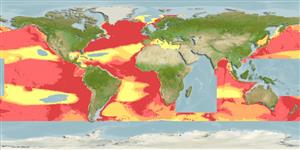Teleostei (teleosts) >
Stomiiformes (Lightfishes and dragonfishes) >
Sternoptychidae (Marine hatchetfishes) > Maurolicinae
Etymology: Maurolicus: Greek,mauros, -os, -on = dark + Greek,lykos = wolf (Ref. 45335).
More on author: Gmelin.
Environment: milieu / climate zone / depth range / distribution range
Ecology
Marine; bathypelagic; depth range 271 - 1524 m (Ref. 5204), usually 300 - 400 m (Ref. 82363). Deep-water; 72°N - 55°S, 180°W - 180°E
Sub-Arctic, and sub-Antarctic waters of the Pacific and Atlantic oceans and the Mediterranean Sea. Eastern Atlantic:: from Iceland and Norway to Senegal and from Democratic Republic of the Congo to Namibia. In tropical and subtropical waters.
Size / Weight / Age
Maturity: Lm ? range ? - ? cm
Max length : 8.0 cm TL male/unsexed; (Ref. 35388); common length : 4.0 cm TL male/unsexed; (Ref. 56527); max. reported age: 3.00 years (Ref. 56527)
Oceanic, found to depths of at least 1,524 m. Migrate in the water column at depths of 150-250 m during the day and to about 50 m at night (Ref. 57912, 107678). Mesopelagic (Ref. 5951); abundant near continental shelf-slope breaks and seamounts, rare in the open ocean (Ref. 107678). A cyclic selective feeder of copepods and euphausiids (Ref. 4739). They become sexually mature when 1 year old. Spawning takes place in March - September, producing 200-500 eggs, floating on the surface (Ref. 35388). Lipid content is 5.5 % in fresh body weight and wax ester is 15.3 % in total lipids (Ref. 8966).
Spawns at least twice in in a lifetime (Ref. 57912).
Wheeler, A., 1992. A list of the common and scientific names of fishes of the British Isles. J. Fish Biol. 41(suppl.A):1-37. (Ref. 5204)
IUCN Red List Status (Ref. 130435)
Threat to humans
Harmless
Human uses
Fisheries: minor commercial
Tools
Special reports
Download XML
Internet sources
Estimates based on models
Preferred temperature (Ref.
123201): 3.2 - 13.3, mean 7.1 °C (based on 301 cells).
Phylogenetic diversity index (Ref.
82804): PD
50 = 0.5000 [Uniqueness, from 0.5 = low to 2.0 = high].
Bayesian length-weight: a=0.00661 (0.00457 - 0.00956), b=3.23 (3.13 - 3.33), in cm total length, based on LWR estimates for this species (Ref.
93245).
Trophic level (Ref.
69278): 3.0 ±0.0 se; based on diet studies.
Generation time: 1.2 ( na - na) years. Estimated as median ln(3)/K based on 1
growth studies.
Resilience (Ref.
120179): Medium, minimum population doubling time 1.4 - 4.4 years (K=0.88; Fec=200-500; tm=1).
Fishing Vulnerability (Ref.
59153): Low vulnerability (10 of 100).
Climate Vulnerability (Ref.
125649): Low vulnerability (23 of 100).
Nutrients (Ref.
124155): Calcium = 111 [41, 279] mg/100g; Iron = 0.673 [0.291, 1.900] mg/100g; Protein = 16.8 [15.2, 18.4] %; Omega3 = 0.2 [0.1, 0.5] g/100g; Selenium = 16.4 [5.1, 46.0] μg/100g; VitaminA = 51.8 [6.4, 402.7] μg/100g; Zinc = 0.988 [0.527, 1.989] mg/100g (wet weight);
